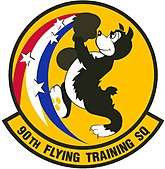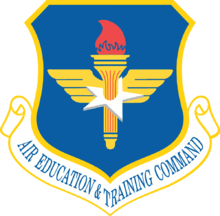90th Flying Training Squadron
The 90th Flying Training Squadron is part of the 80th Flying Training Wing based at Sheppard Air Force Base, Texas. It operates Northrop T-38 Talon aircraft conducting flight training.
| 90th Flying Training Squadron | |
|---|---|
 90th Flying Training Squadron T-38 Talon | |
| Active | 1942–1945; 1973–present |
| Country | |
| Branch | |
| Role | Pilot Training |
| Part of | Air Education and Training Command |
| Garrison/HQ | Sheppard Air Force Base |
| Nickname(s) | Burma Banshees (World War II)[1] |
| Engagements | China-Burma-India Theater[2] |
| Decorations | Distinguished Unit Citation Air Force Outstanding Unit Award[2] |
| Commanders | |
| Current commander | Lt Col Andreas Hauke, GAF |
| Insignia | |
| 90th Flying Training Squadron emblem (approved 19 January 1945)[2] |  |
| Unofficial 90th Fighter Squadron emblem (CBI Theater[3] | .png) |
History
World War II
The 90th flew combat missions in the China Burma India Theater from 16 September 1943 – 29 April 1945.[2] While stationed at Moran, India, on 8 June 1944, the squadron again received Republic P-47 Thunderbolts. It flew its first combat mission with Thunderbolts on 25 June, having transferred its Curtiss P-40 Warhawks to the depot in Karachi or to the 88th Fighter Squadron.[4]
Lineage
- Constituted as the 90th Pursuit Squadron (Interceptor) on 13 January 1942
- Activated on 9 February 1942
- Redesignated 90th Fighter Squadron on 15 May l942
- Redesignated 90th Fighter Squadron (Single Engine) on 1 July 1942
- Redesignated 90th Fighter Squadron, Single Engine on 28 February 1944
- Inactivated on 3 November 1945
- Redesignated 90th Flying Training Squadron on 25 May 1972
- Activated on 1 January 1973[2]
Assignments
- 80th Fighter Group, 9 February 1942 – 3 November 1945
- 80th Flying Training Wing, 1 January1973
- 80th Operations Group, 2 January 1998 – present)[2]
Stations
|
|
Aircraft
- Republic P-47 Thunderbolt (1942–1943, 1944–1945)
- Curtiss P-40 Warhawk (1943–1944)
- Northrop T-38 Talon (1973–present)[2]
gollark: (in esolangs)
gollark: I require input on my question, I SAID this.
gollark: Gaze upon my superior emojic technology, <@711227962401226793>.
gollark: <:emoji_39:802634893510967326><:emoji_37:802634361459179540> <:emoji_38:802634841841336340><:emoji_36:802634312960704573>
gollark: I am not signed into my mother's amazon account on my laptop.
References
Notes
- Pons, p. 272
- Kane, Robert G. (29 March 2010). "Factsheet 90 Flying Training Squadron (AETC)". Air Force Historical Research Agency. Retrieved 24 August 2017.
- Pons, p. 276
- Pons, p. 273
Bibliography
- Maurer, Maurer, ed. (1983) [1961]. Air Force Combat Units of World War II (PDF) (reprint ed.). Washington, DC: Office of Air Force History. ISBN 0-912799-02-1. LCCN 61060979. Retrieved 17 December 2016.
- Maurer, Maurer, ed. (1982) [1969]. Combat Squadrons of the Air Force, World War II (PDF) (reprint ed.). Washington, DC: Office of Air Force History. ISBN 0-405-12194-6. LCCN 70605402. OCLC 72556. Retrieved 17 December 2016.
- Pons, Gregory (Winter 2017). ""Burma Banshees" 90th Fighter Squadron P-47s". AAHS Journal. American Aviation Historical Society. 62 (4): 272–277.
- Ravenstein, Charles A. (1984). Air Force Combat Wings, Lineage & Honors Histories 1947-1977. Washington, DC: Office of Air Force History. ISBN 0-912799-12-9. Retrieved 17 December 2016.
External links
This article is issued from Wikipedia. The text is licensed under Creative Commons - Attribution - Sharealike. Additional terms may apply for the media files.

